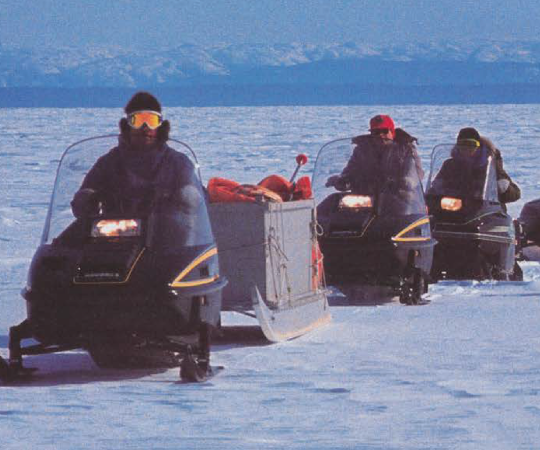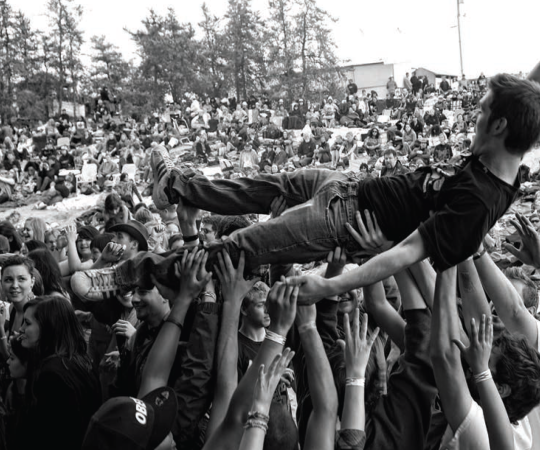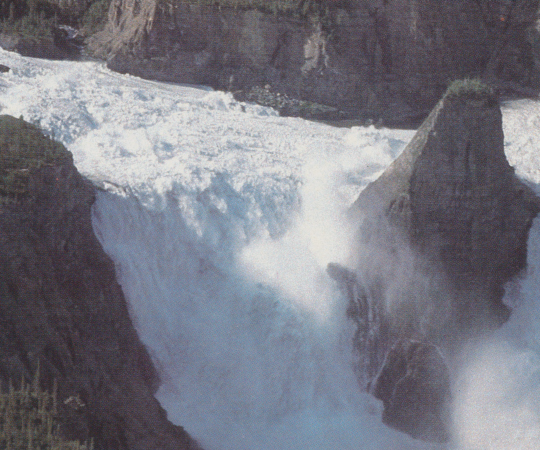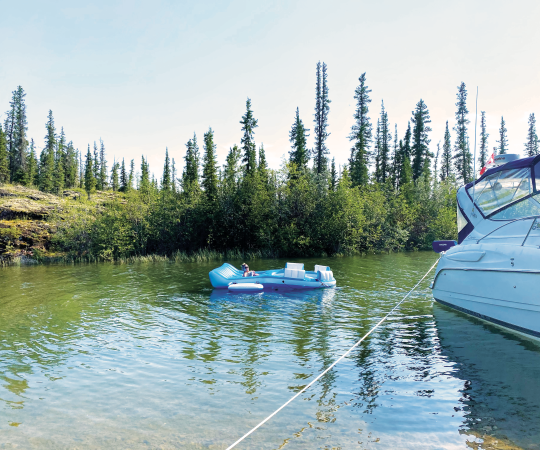We spot the grizzly napping in an alpine meadow on the mountain pass we have climbed. She is flat on her back with her belly to the sun and a paw draped across her muzzle shield to her eyes from the noonday sun. My partner John and I pull our bear spray canisters from their holsters and steady ourselves for the bluff charge.
Only it doesn’t happen. She’s remains asleep.
Despite all our talking, we have somehow hiked upon a slumbering grizzly bear without waking her. Still, this situation is less than ideal. Startling a grizzly on its day bed is a leading cause of an attack, so we begin tiptoeing away as silently as we can. At the same time, we pull the safety tabs off our bear spray.
How foolish to think we could sneak away unnoticed. I trip on a boulder and kick off a small slide of rocks. I look at the grizzly to see if she heard me.
She has. And she’s running towards us.
***

Tucked in the southwest corner of the Yukon, Kluane National Park and Reserve is home to Mount Logan, Canada’s tallest mountain, and preserves the world’s largest non-polar icefield. Less known but equally impressive, Kluane is also home to North America’s largest and most genetically diverse population of grizzly bears. Traveling in Kluane is to travel among grizzlies.
When a grizzly charges, time distorts. Your mind goes blank, your body tenses. There is no way to know whether a charge will be a bluff or an attack. All you can do is wait and see—and find some comfort in knowing that, statistically, it will likely be a bluff charge.
It’s startling to witness how quickly a grizzly can go from dead asleep to a full run. You can barely utter ‘oh shit’ before the grizzly has changed its course and is fleeing. Reaching for the bear spray is almost an afterthought.
Thankfully for us, this grizzly ends her bluff charge 50 metres away then turns and trots back to her bed, where only moments before she slept. From her alpine meadow, she fixes her gaze upon us just as we keep our eyes on her.
Moments pass by. No one dares to move.
John and I look at each other, hoping the other has a suggestion about what to do. This was supposed to be a straightforward three-day backpack. After a day of grueling bushwhacking, we intended to spend these next two days leisurely exploring this mountain pass—maybe skinny dipping in an alpine lake or climbing a peak.
But now we just want out—and as quickly as possible. It is too late in the day to turn around and reach our car before nightfall. I am not too keen to sleep in the thick forest, so close to a grizzly we have bothered.
If we keep moving forward though, we might have enough daylight to reach the Alaska Highway, six hours away. And we would be in the open alpine for most of it with just a few hours of willowy subalpine hiking. We choose this exit, but that means trying to skirt around a very attentive grizzly.
We move slowly, hesitantly. I begin prattling in a friendly tone, avoiding eye contact. We keep to the west side of the mountain pass, leaving at least 100 metres on the other side for the grizzly. The hope is the griz will see where we’re going and will go the other way.
But she doesn’t comply. She starts strolling in the same direction, so John and I immediately stop and sit, to rest trembling legs and give the grizzly time to go wherever she chooses.
Only she decides to sit on her haunches as well. We try moving again and so does the grizzly. Once more we sit. And she does as well.
At an impasse with a grizzly, our fear slowly dissolves into curiosity.
***
Is it reckless to wander into a wilderness with the highest concentration of grizzlies in North America? Not necessarily. There are risks in every backcountry, trip but that is part of the appeal: to endure the physical and mental hardships and face one’s fears. Anyone who frequents the backcountry not only understands and accepts the risks, but tries to minimize them as well.
Just as backpackers must learn how to safely cross rivers and navigate when there are no trails, we need to learn how to travel safely in grizzly territory. We do this by reading all there is about bear behaviour, and how to travel and camp among them. We also learn to read their body language. We watch the instructional bear safety videos provided by national and territorial park staff. And we etch all of this information into our memory.
Once outside, we travel cautiously, armed with bear spray and all that knowledge gleaned ahead of time. If camping, we carry bear-resistant food canisters for storing food, even if they are heavy and cumbersome. We pack food with little odour and keep the tent and sleeping gear free of scents. We hike slowly and loudly when necessary. Half of all grizzly attacks involve dogs, so we keep dogs on a leash and under control—or we leave them at home if they’re unruly. Facing a grizzly is not the time to realize your dog is not well behaved enough to stay calm when the situation requires it the most.
Having spent much time outside in the past twenty years, I have learned a few tricks of my own for traveling in grizzly country. I listen for changes in bird songs and heed the warning whistles and peeps of marmots, arctic ground squirrels and picas. They too are on the lookout for predators and will loudly announce this presence. Their vigilance and keen senses work to our benefit, now that I know to listen to their warning cries.
It is exhausting to always be alert, constantly listening and scanning our surroundings, hypervigilant and calling out into the void when bushwhacking. But in doing so, we minimize the chances of a dangerous encounter.
***
John and I have met plenty of grizzlies before, in varying situations. There are the nonchalant ones that ignore us and go about their days. These bears are easy to travel among. We just keep our distance.
We have startled a couple and been bluff-charged, but most grizzlies bolt at the first whiff of us. As long they don’t feel threatened or cornered, grizzlies and black bears are usually as eager to get away from humans as we are from them.
But this grizzly, mimicking our movements and showing no signs of stress or aggression—no huffing or head shaking, no swatting the ground with her paws—is perplexing. How do we appease her?
We want her to take the lead and make her own choices, but since she doesn’t seem to catch on to our hints, we decide to get up and keep to our original route, staying on our side of the valley, which is broad enough to keep us at least 100 metres apart. We give her as much space as the terrain will allow. We do our best to look nonthreatening by chatting softly and not looking directly at her. Once again, the grizzly resumes her saunter, keeping pace with us, but to her side of the valley.
As the afternoon wears on, the grizzly continues to show no concern. My nervousness slowly dissipates and the next two hours are idyllic, sharing a mountain valley with a grizzly.
That is, until we lose sight of her when we descend into the shrubby subalpine. Now, our fear and trepidation returns. Unable to see beyond the towering willows, I take up prattling loudly, nervous we might stumble into her a second time. We have already surprised her once and gotten away with it. I don’t want to push our luck by startling her again.
But we do. After a particularly grueling stretch of bushwhacking, we walk into a small meadow where the grizzly is grazing on cow parsnip just a few metres away. She looks at us with the most unconcerned reaction, as if she was anticipating us. “Sorry girl,” I say. She returns to grazing and we hop over the creek and scurry into a side valley that will take us out of the backcountry in a couple of hours.
We are aware of our good fortune on this day and are keenly aware of what could have been. Despite the uncertainty and risks involved with accidentally startling a slumbering grizzly, it is exactly these experiences that call us back into the backcountry of the Canadian North.
To share an alpine valley with a grizzly makes for a good story, but it’s also a humbling situation. Despite twenty years of backcountry experience, I am not impervious to the fear a grizzly elicits. I have yet to snap a non-blurry photo of a grizzly simply because I cannot steady my trembling hands. Even when they are running away, disappearing over a mountain, my photos come out blurry. The mind might know the danger has passed, but my body needs more time.
I don’t think I’ll ever rid myself of that fear, but I do not let it keep me indoors.









